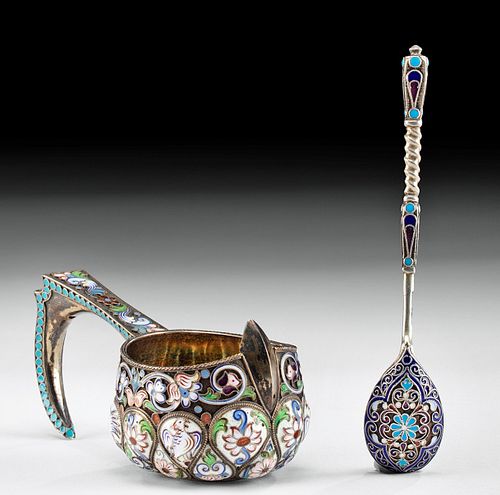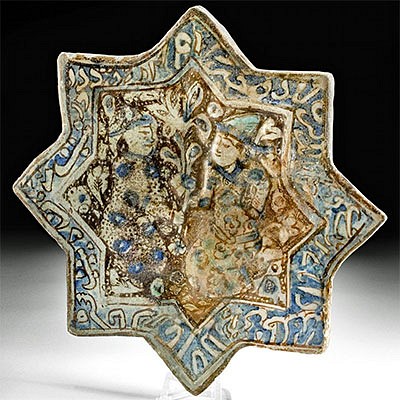19th C. Russian Cloisonne Silver Kovsh and Spoon
Lot 340
About Seller
Artemis Fine Arts
686 S Taylor Ave, Ste 106
Louisville, CO 80027
United States
Selling antiquities, ancient and ethnographic art online since 1993, Artemis Gallery specializes in Classical Antiquities (Egyptian, Greek, Roman, Near Eastern), Asian, Pre-Columbian, African / Tribal / Oceanographic art. Our extensive inventory includes pottery, stone, metal, wood, glass and textil...Read more
Categories
Estimate:
$800 - $1,200
Absentee vs Live bid
Two ways to bid:
- Leave a max absentee bid and the platform will bid on your behalf up to your maximum bid during the live auction.
- Bid live during the auction and your bids will be submitted real-time to the auctioneer.
Bid Increments
| Price | Bid Increment |
|---|---|
| $0 | $25 |
| $300 | $50 |
| $1,000 | $100 |
| $2,000 | $250 |
| $5,000 | $500 |
| $10,000 | $1,000 |
| $20,000 | $2,500 |
| $50,000 | $5,000 |
| $100,000 | $10,000 |
| $200,000 | $20,000 |
About Auction
By Artemis Fine Arts
May 20, 2021
Set Reminder
2021-05-20 10:00:00
2021-05-20 10:00:00
America/New_York
Bidsquare
Bidsquare : Ancient & Ethnographic From Around The World
https://www.bidsquare.com/auctions/artemis-gallery/ancient-ethnographic-from-around-the-world-6979
Ancient art from Egypt, Greece, Italy and the Near East, as well as Asian, Fossils, Pre-Columbian, Native American, African / Tribal / Oceanic, Fine art, and much more! All categories, all price ranges... all legally acquired and guaranteed to be as described or your money back. Artemis Fine Arts info@artemisgallery.com
Ancient art from Egypt, Greece, Italy and the Near East, as well as Asian, Fossils, Pre-Columbian, Native American, African / Tribal / Oceanic, Fine art, and much more! All categories, all price ranges... all legally acquired and guaranteed to be as described or your money back. Artemis Fine Arts info@artemisgallery.com
- Lot Description
Eastern Europe, Russia, ca. late 19th century CE. A gorgeous pair of cloisonne enamel and gilded, high quality silver dishes: a serving dish known as a kovsh and a spoon. The elegant vessel exhibits an ovoid base, a bulbous body, and a circular rim, flanked by a pointed tab on one side and a lengthy handle that elegantly curves downwards on the other. Alternatively, the petite spoon presents a shallow bowl and a twisted handle with a flared tip. Both beautiful pieces are adorned with vibrant cloisonne in hues of blue, pink, green, yellow, purple, red, and white arranged into intricate floral and vegetal motifs accompanied by some geometric and linear patterns. Kovsh are traditional drinking vessels with shapes that may reflect Viking longships. Over the ages their designs and materials became more ornate, and pieces like this set eventually became symbolic gifts presented by the Tsar to important members of government or citizens. Silver quality: kovsh: 94.3%, spoon: 90%; Size of largest: 3.75" L x 1.75" W x 1.75" H (9.5 cm x 4.4 cm x 4.4 cm); Weight: kovsh: 66.8 grams, spoon: 19 grams
On the base of the serving dish are 3 hallmarks. The first shows a face in profile to the right with the number "88" to indicate Russian silver purity. The second hallmark is a double-headed eagle, indicating that it was made in Moscow, and the third is a maker's mark comprised of Cyrillic script. The spoon also displays 3 hallmarks, though these are located on the side of its stem: an assay mark, a makers mark, and "84" with a profile head designating the Russian silver purity.
From the mid-19th century to the early 20th, Russian art of all kinds experienced a renaissance that is known as the Silver Age. Russian artisans were inspired by the Gothic, the Moresque, Chinoiserie, the Baroque, the Rococo - all ornate styles, replete with scrolling vines and flourishing arches. They combined this with the bright colors and rich ornament of Old Russian applied art to create a unique style of which silver items like this vessel, are some of the most enduring. Later Russian artists in the 20th century recreated the styles pioneered by famous Russian silversmith firms like Ovchinnikov, Kurlyukov, the Grachev Brothers, and Faberge.
Provenance: ex-Collection of James Farmer, Maryland, acquired from major galleries and auction houses between 1995 and 2005
All items legal to buy/sell under U.S. Statute covering cultural patrimony Code 2600, CHAPTER 14, and are guaranteed to be as described or your money back.
A Certificate of Authenticity will accompany all winning bids.
We ship worldwide and handle all shipping in-house for your convenience.
#120556Intact and excellent with lovely patina.Condition
- Shipping Info
-
All shipping is handled in-house for your convenience. Your invoice from Artemis Gallery will include shipping calculation instructions. If in doubt, please inquire BEFORE bidding for estimated shipping costs for individual items.
-
- Buyer's Premium



 EUR
EUR CAD
CAD AUD
AUD GBP
GBP MXN
MXN HKD
HKD CNY
CNY MYR
MYR SEK
SEK SGD
SGD CHF
CHF THB
THB
















